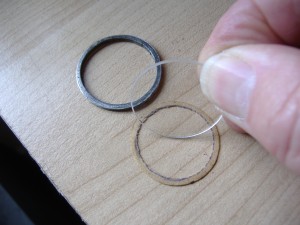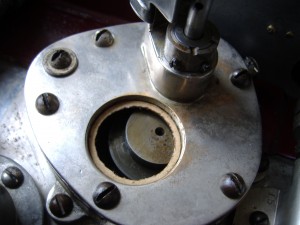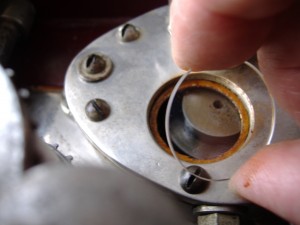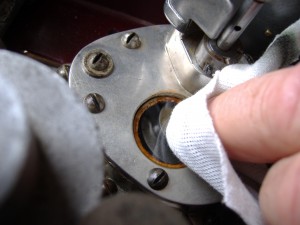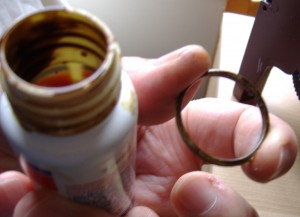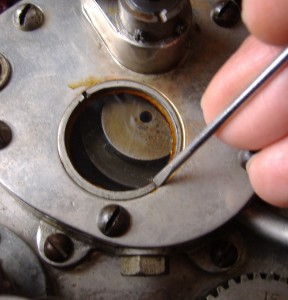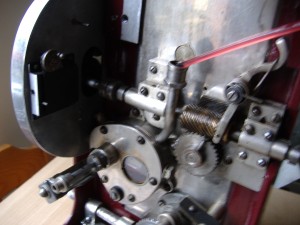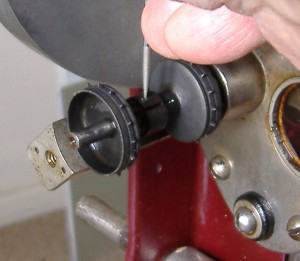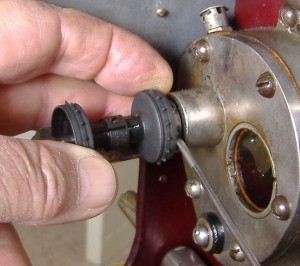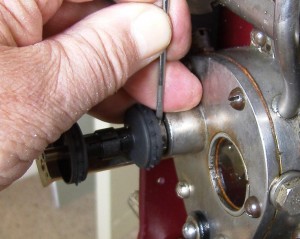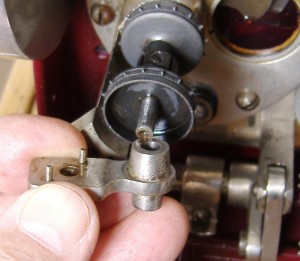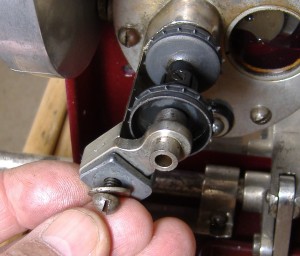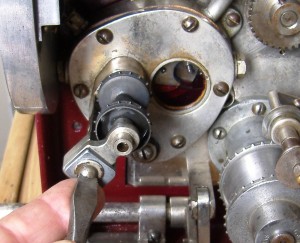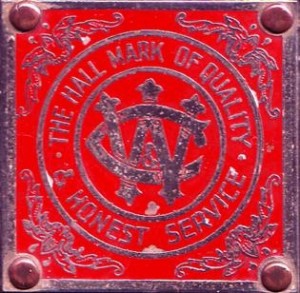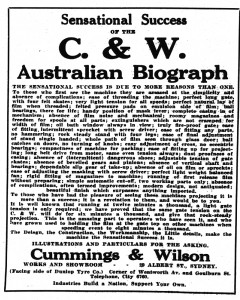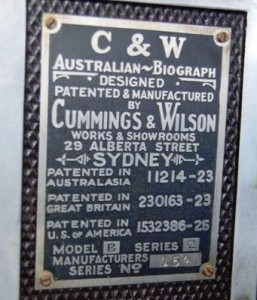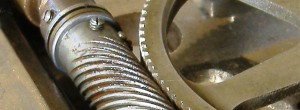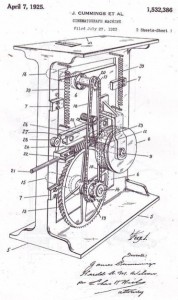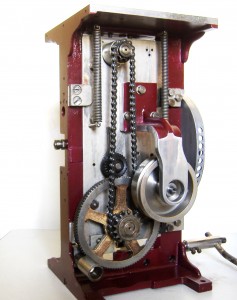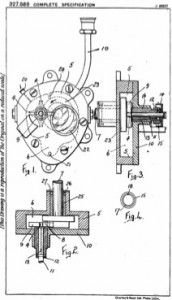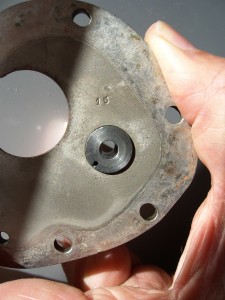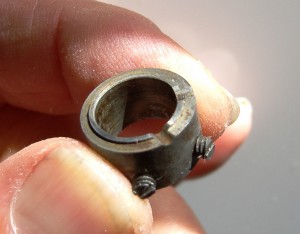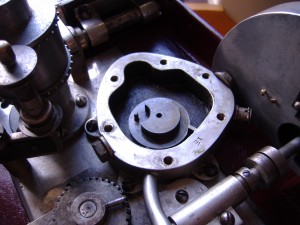Australian Biograph
Designed ,Patented & Manufactured by CUMMINGS & WILSON
WORKS & SHOWROOMS, 29 ALBERTA ST. SYDNEY
PROJECTORS OWNERS WORKSHOP MANUAL
An insight into owning, restoring, servicing and running Cummings & Wilson Film Projectors
A projector’s reputation,
like a mans character is built, not conferred
A mans character is what he makes it
Similarly a projector’s reputation must be earned
James Cummings

Advertising the coming of Al Jolson Talkie, The Jazz Singer

December 20 1928 sees the installation of the Vitaphone sound equipment at the Lyceum Theatre Sydney on their Cummings & Wilson Senior projectors in preparation for the premier of the Warner Bros. Jazz Singer in the first weeks of January 1929.
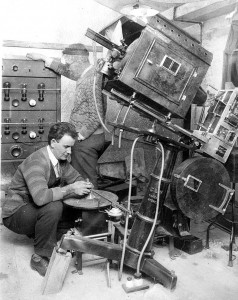
One of the two Cummings & Wilson Model D’s at Lyceum Theatre ,Sydney December 1928 being fitted with Movietone sound heads and Vitaphone sound-on-disc Equipments prior to the first showing in the Jazz Singer
C&W ACHIEVEMENTS over 40 years 1922 to 1962
Cummings & Wilson is the first Australian made cinema projector known as the Australian Biograph. It was designed and made in their works and showroom at 29 Alberta Street Sydney, announced June 14 1922. Known as the model A, it is thought that 6 were made in the last 6 months of that year.
The model B started being made in the first week of 1922, at least 14 were made and installed and were running in 7 theatres’ from Balmain to Bondi. There are only 4 model D’s are known to exist at present (2013).
By 1924 many more were made, and Hamilton and Baker, electrical, biograph and wireless supplies of Sydney, took up the sales and distribution of the C&W projectors.
In September 2 1924 C&W projectors two model A’s, no. 2 and 3 were chosen, and ran a special screening or the new 14000 foot feature The Ten Commandments at the Hotel Australia. Many of the reels were in the new colour process.
With the arrival of the new De Forest Phonofilm Company in Sydney in November 1925, a C&W projector installed with the Phonofilm sound heads. They were chosen to demonstrate new movie sound throughout NSW.
Although not an achievement, we must note the passing of James Cummings on August 28 1926, he was aged 58 years. Harold Wilson now carried headed the company.
In March 24 1927 Everyones Magazine noted record sales for the C&W. In the last 21 days 19 projectors have been sold they said. In the 5 years since they had started manufacturing, to October that year 1927, 225 model D’s had been made.
In May 1927 Sound film, taken by Bell & Howell cameras, fitted with a De Forest Photophone sound recording head, of the Royal Visit of the Duke and Dutchess of York in Australia was made of the of their arrival, and visit to Sydney, and new Parliament House in Canberra. Sound films were showed daily, which showed the daily travels and festivities of the Royal couple. These were shown the Royal Visitors using two sound fitted C&W projectors at Sydney’s Government House.
On March 14 1928 two C&W projectors were installed in the newly built the mighty Regent Theatre in Sydney, and two more were installed in the new Wintergarden Theatre at Rose Bay in September 1928. They were the latest C&W model D
In December 1928 two new C&W projectors, fitted with Movietone sound-on-film heads and Vitaphone sound-on-disc sound reproducers ready for the Australian premier of the sound film Al Jolson’s Jazz Singer
August 1930 announces the arrival of the new C&W model E rear shutter projector. Earlier made machines could be returned to the works and be fitted with rear shutters
The next big announcement is of the arrival of the C&W Junior on July 20 1932. It is installed in a couple of the newly emerging sound projector companies, including the new Raycophone Portable. It had an external rear shutter just like its big brother, now called the “Senior.”
In January 19 1933, Raycophone portables were now installed in many P&O Pacific cruisers ships. By May 24 1933, there was now 69 C&W “Junior” fitted Raycophone portable projectors sold. By January 1934 these portables were being installed and used many hospitals and private homes in Sydney.
By November 1934 it is reported that 784 C&W projectors were now in use in Australia theatres.
September 5 1935, C&W announce the new deluxe model D internal shutter model. The fan shaft drive is now fitted on the operating side of the projector, using the same fitting and parts as the Junior P5 series.
By March 1937 C&W celebrated the 1010th projector made which is now running in Australia. 1200 had been sold by the following January. The rise is no doubt due to the acceptance of the new P6 C&W picture head, which was about to be released fitted to the new Raycophone J3 projector released in October 1938.
Through the war years C&W, as well as other war work, still made a limited number of machines, many were used by Raymac Company on their projector. They made projector for sale to the Navy warships for both Australian and USA.
Raycophone apart from making artillery gun sites still supplied and provide J3 projectors to show training films for the services.
The Raycophone J3 projectors were also in demand for small theatrettes which shows news war film and other news short features.
By the end of WWII C&W had resumed normal trading by December 1945.
January 24 1946 Raymac projectors were again chosen for warship as on board entertainment. Raymac chose special C&W P7E for their projectors E stands for external shutters.
January 9 1947 Raycophone announced their new CP7/102 projectors. They were fitted with C&W P7 mechanisms. In January it was announced the Raycophone were also fitted with CP7A projector heads.
In April 1949 Western Electric announced their new projector range which included the smaller Westrex 20 projector. These new machine were fitted with the new C&W P8 and P8 LS models heads. The C&W P7E stand alone projector heads were still being made.
By September 1952 the new C&W model G’s were announced. They were being made in single and twin shutter models. They had large diameter lens mounts, new rotating cam and Maltese cross intermittent assembly’s, parallel opening removable gates and newly designed body case assembles.
In May 1953 sees the installation of 2 C&W Seniors in the Warner Brothers Theatrette to show previews of the new 3D movie The House of Wax. The projectors had special polarising filters and were interlocked using selsen motors drives. They had RCA sound heads.
1954 Raycophone announces the new CP10 anniversary projector.
They were fitted with large barrel lens mounts and were fitted with C&W M2 and ML C&W integrated projector heads. Later C&W made the M1 and M2 stand alone projectors in which the spindle shaft was now on the flywheel side of the projector.
In 1960 it was known that a new 70 mm C&W model G was on the drawing board, but a prototype however was never made.
Advertisement in Everyones magazine December 1923
The C&W front shutter model
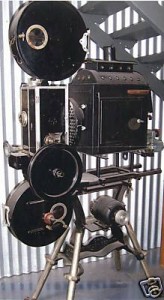
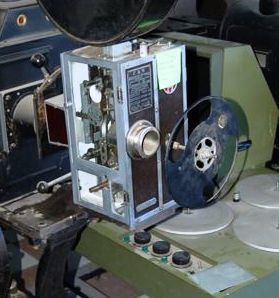
Introduction to the C&W senior models
I have intentionally tried where possible to keep the number sequence of the projectors in order, starting with the earliest lowest number.
First will be the C&W model D number 225, followed by the model D number 328 followed by model E number 502 in the assembly pictures.
C&W number 225 has been called the burnt one, because most of the casing was destroyed in an unfortunate nitrate film fire. The mechanism, while showing some particular burn marks, was fortunately kept intact, and was cleaned up before the photographs of the assembly were being taken.
The images start with the cleaning up of the intermittent movement, and then show the assembly. I have put in an image of the patent drawing; this should help show you how it was constructed.
Many of the model D’s were converted from front shutter to rear shutter at the factory, when it was found that the rear shutter was much improved, firstly with the amount of light, and secondly with the amount of cooling the rear shutter blades gave to the film gate.
The first images are of the model D showing the flywheel side shows the front shutter.
C&W Senior Model D front shutter
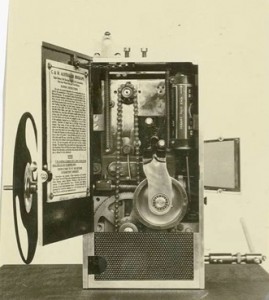
Flywheel side of the C&W model D showing the front shutter and driving gear and Flywheel.
Two Cumming & Wilson model D projectors No. 224 and 225 were burned in a recent nitrate film fire when they were stored.
The two projector cases were destroyed beyond restoration, however most of the mechanism was sufficiently intact to bring them back into life again.
Although the pair started life on October 24 1927, they were returned to the C&W works and remade as internal shutter model H’s in July 22 1938, again as a pair and retained the original numbers. Unfortunately there is no record of their history, but they were certainly used in WA. It was quite normal for earlier machine to be returned back to C&W for an up grade to model E or EH.
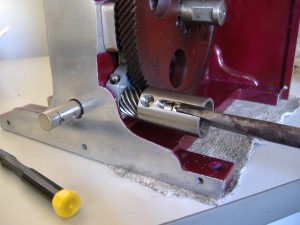
The C&W Senior model D No. 225 (Burnt one)
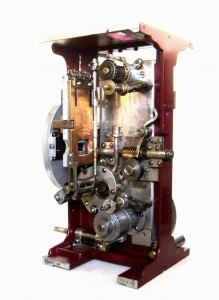
The lens mount was not saved, and the case was too damaged and had melted. Much of the internal mechanism was been saved however.
The next set of pictures shows the assembly of the intermittent movement, and the re-assembly to running condition again.
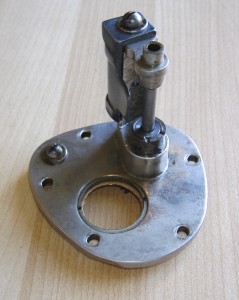
C&W British patent drawings No. 327588 detail at Fig 3-12 the annular grove, at Fig 3-13 the oil-way boring and exit to the oil bath
The bushing for the intermittent sprocket shaft has near its outer end an annular grove and an oil-way from this groove to the interior of the oil bath. The small hole of the oil-way can be seen as a black spot in the annular groove, the plugged up drilling hole can seen as the light colour metal filling on the face of the bushing
The inner end of the bushing shows the exit of the oil-way into the oil bath. This is at a downward angle of 10° from the outward end of the cover
The outer end of the bushing is fitted with an adjustable collar able to bear against the intermittent sprocket to minimise the end play of the Maltese cross, after adjustment is fixed in place with two grub screws
Contact to the intermittent sprocket is made with the reduced edge of the collar
The two gaps machined in the collar allows air to enter the intermittent shaft to the bushing grove creating an area of relatively low pressure at the oil-way exit.
The assists the return of oil to the oil bath
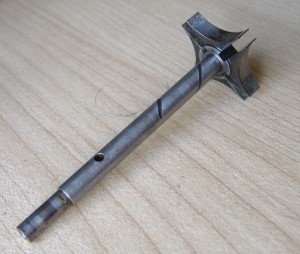
Note the scrolling cut along the helps to carry oil along the bearing
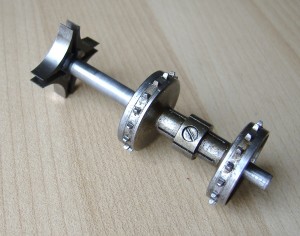
The picture shows the intermittent cam and actuating pin which engages the slots in the Maltese cross. The surface is cleaned ready to receive coating of gasket sealant
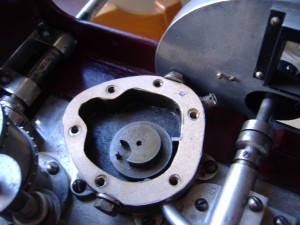
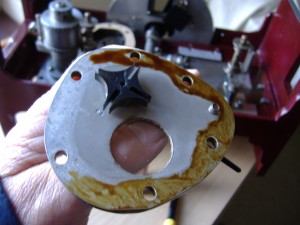
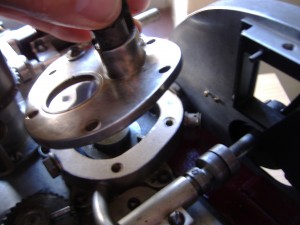
Moving the cover laterally to ensure correct engagement of the cam and cross.

At this moment with the two screws loose rotated the camshaft flywheel, listen and feel for even engagement trough four rotations of the cam.
